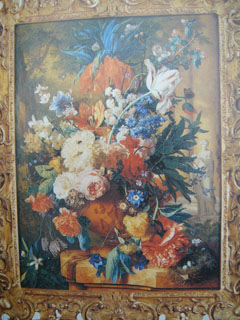The eighteenth-century master Jan van Huysum, the most swaggeringly inventive of the Dutch fruit and flower painters, is fairly well represented in British public collections. The National Gallery, for example, owns a couple of good examples of his work. But Van Huysum’s two most brilliant and perfectly preserved paintings remain in private hands. Neither has been publicly exhibited for almost fifty years – until now. Their owner, who lives in London, recently placed both on loan to the Dulwich Picture Gallery for the summer. Designed as a pair, one shows mostly fruit, the other flowers. The latter is this week’s suitably blooming choice of picture.
The principal source of information about Van Huysum is a short biography written by his contemporary Johan van Gool, who describes him as a secretive and even rather paranoid individual. According to Van Gool, he suffered from severe hypochondria and an apparently baseless lifelong conviction that his wife was cuckolding him. He seems to have regarded the outside world with equal suspicion, reputedly refusing to take on pupils (with the exception of a young woman called Margareta Haverman, the daughter of a friend, whom he instantly dismissed once she started showing some talent) for fear that they would steal his “secrets”.
Van Huysum’s gifts were such that he need not have worried about the competition. No other painter of his time understood as well as he how to delineate, in all their varieties of form and hue, the fashionable and extremely costly blooms – hyacinths, fritillaries, peonies, roses, tulips, chyrsanthemums – cultivated so assiduously by the well-to-do and their diligent gardeners. None could paint those small, trompe l’oeil details, the still-life painter’s flaunts of his own ingenuity, with anything approaching his deceptive ease. He was the undisputed master of the poised fly, the creeping caterpillar,...


